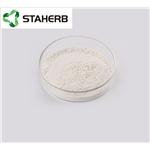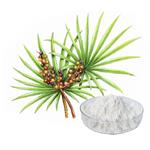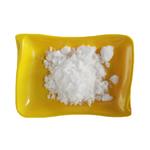Chemical Properties
White crystals or crystalline powder
Uses
Composition of plum leaf polysaccharides.
Uses
L-Rhamnose monohydrate is a deoxy sugar found in plants and bacteria.
Uses
L-Rhamnose monohydrate is a deoxy sugar in plants and bacteria. It is a component of plant cell walls that helps maintain structure. L-Rhamnose monohydrate is used as a starting material for the production of furanones. It is an important material involved in the reaction of flavors developed during the preparation of various foods like bread, grilled meats, etc.
Biological Functions
L-Rhamnose is a part of plant cell wall polysaccharides, rhamnogalacturonan I and rhamnogalacturonan.It is also present in bacterial cell walland a major antigenic determinant contributing to its pathogenicity.L-rhamnose is non-absorbable in humans but is fermented by intestinal microbes. Supplementation of L-rhamnose slows down gastric emptying. L-rhamnose monosaccharide conjugated immunogens have applications in cancer immunotherapies. Intake of L-rhamnose elevates serum propionate levels.
L-Rhamnose monohydrate has been used:
in biofilm enhancement assay in S.pneumonia.
as a sugar drink in humans undergoing intestinal barrier permeability test.
for the standard curve generation in high performance liquid chromatography(HPLC).
General Description
L-Rhamnose is a part of plant cell wall polysaccharides, rhamnogalacturonan I and rhamnogalacturonan. It is also present in bacterial cell walland a major antigenic determinant contributing to its pathogenicity. L-rhamnose is non-absorbable in humans but is fermented by intestinal microbes. Supplementation of L-rhamnose slows down gastric emptying. L-rhamnose monosaccharide conjugated immunogens have applications in cancer immunotherapies. Intake of L-rhamnose elevates serum propionate levels.
Purification Methods
Crystallise the rhamnose from H2O or EtOH. It crystallises easily as the monohydrate by evaporating a solution in MeOH (90%) and H2O (10%). It is also purified by dissolving in a small volume of EtOH, adding a few drops of H2O and cooling. 1H NMR in D2O at 44o contains 60% -pyranose and 40% -pyranose forms [Angyal Adv Carbohydr Chem 42 15 1984.] [Smith J Chem Soc 1035 1940, McGeachin & Beevers Acta Cryst 10 227,230 197, Beilstein 1 IV 4261.]




